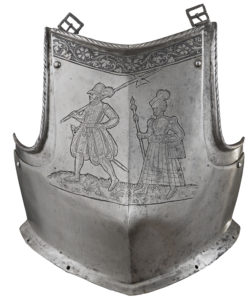Mention the word “armour” and the imagination fires — those knights in their polished suits of steel, their mighty steeds snorting, their fair maidens cheering as dragons are slain.
That’s the romantic imagination, anyhow. Few people think of armour as it’s still so commonly used today, though that may change after they see Armour, the new exhibition at the Canadian War Museum. The artifacts range from those storied days of yore to today’s fields of law enforcement, sports and entertainment.
The exhibit doesn’t cover the entire history of armour. It comes from the Museo Stibbert in Florence, Italy, once the home of collector Frederick Stibbert, who had a thing for arms and armour of the medieval and Renaissance eras. The oldest items here date to the late 15th century.
There are two streams of craft going on in their design, including the craft/science of better protecting the person inside the armour (the strength of the steel plate, the shape of a breast plate or helmet to better deflect a blade), and the craft/art of the etching and designs that cover the surface — the arms, the legs, the torso, the head, all of them made as beautiful as they are formidable.
One case contains a “youth’s suit of armour” from the late 1500s, “likely made for the son of a powerful family. It is lavishly engraved with intertwining motifs, elements of armour, and musical instruments.” Next to it is a “Parade Corselet,” made of steel, bronze, leather and velvet, and described on an adjacent card as “Full-Body Jewellery.”
The decorations on armour were a veritable record of life as it was some 600 years ago — at least, as life was seen for the wealthy and royal, as plainer armour used by ordinary soldiers is less likely to have survived over the centuries. A pair of leg protectors made in the Netherlands in 1580 are completely covered, from thigh to ankle, in “lavish decorations” including “castles and mounted knights in a forest landscape.”
It’s fascinating to see how these decorations have changed, or disappeared, over the centuries. The glory days of armour faded away as firearms improved: look for the breastplate from Italy in the early 1600s that has dents from test bullets fired by its maker. “Ultimately, the steel plates of a suit of armour had to be so thick that the weight was unbearable.”
It’s ironic, then, that some armour so commonly used today is expressly to stop bullets. Exhibits include the shirt and Kevlar vest that OPP officer Scott Couse was wearing in 1992 when he was shot twice, once in the chest. The vest stopped that bullet before it reached his heart, and a text card chillingly notes, “The red stain on the shirt is from the pen he was carrying in his breast pocket.”

This steel breastplate features high-quality engravings. It was made in Italy from 1550–1560. Courtesy Museo Stibbert
Where elaborate decoration continues is in the athletic “armour” of today, including helmets used by cyclists, boarders, and football and hockey players. There’s an entire set of goalie equipment from Team Canada netminder Shannon Szabados, and though most people have likely never thought of it as “armour,” it in every way is.
There are also bits of entertainment on display.
On loan from Warner Brothers is the “bullet farmer” costume from best-picture nominee Mad Max: Fury Road. A lethal-looking crossbow from the late 1500s brings to mind Game of Thrones’ Tyrion Lannister as he (spoiler alert!) fires a bolt through his father in the privy.
Interactive elements include a Captain America shield that visitors can hold and pose with, or touch screens where people can design their own helmet. Mine was basic white with flames and an orange unicorn horn, and I’m confident it would send my enemies fleeing the field in aesthetic horror.
This is an expansive exhibition of armour, and the broad inclusion of contemporary examples makes it accessible and instructive, and likely to change how one thinks of armour — not as an ancient thing, but as timeless and very much a part of daily life today.
Still, it’s the romantic tales that pull in the crowds. In the museum lobby on Thursday visitors gathered around a cordoned-off area in which two “knights” battled with swords. It was exciting, even if the knights’ armour lacked a certain verisimilitude: beneath one knight’s steel leggings was a pair of blue jeans. Of course, if those were authentic medieval Levi’s, they’d be worth a king’s ransom on eBay.
Armour continues to Sept. 3.






